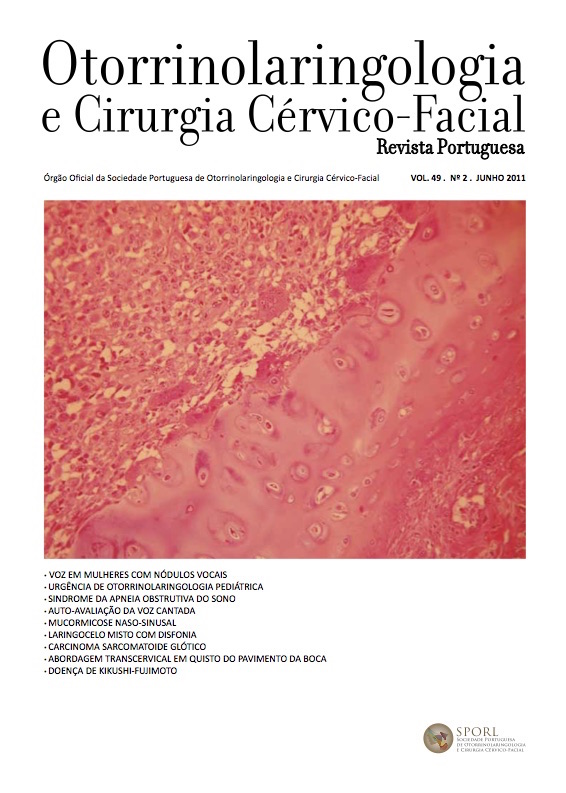Nasosinusal mucormycosis – clinical reports and literature review
DOI:
https://doi.org/10.34631/sporl.164Keywords:
Sinusitis, fungus, amphotericinAbstract
Mucormycosis is a life-threatening fungal infection, commonly with fatal evolution. This fungus is a saprophytic organism which can become pathogenic in specific conditions, particularly in immunocompromised patients (diabetes mellitus, especially those with ketoacidosis; solid malignancies, haematologic malignancies, patients undergoing treatment with glucocorticosteroid). The disease process starts with inhalation of the fungus into the paranasal sinus. The fungus may spread to invade the palate, sphenoid sinus, cavernous sinus, orbits or cranially to invade the brain. The keys to successful therapy include suspicion of the diagnosis and early recognition of the signs and symptons, correction of underlying medical disorders, aggressive medical and surgical intervention.
We report three cases of rhinocerebral mucormycosis in immunocompromised patients (males), mean age 70 years with histopathological diagnosis of mucormycosis, treated in the last year (2009), at the Hospital S. José. All patients were treated with amphotericin B and two of them had surgical debridement of involved tissue. Two dieds.
Mucormycosis rhino-sinusal is a serious clinical that requires an exact diagnosis and a quick treatement, since it still causes high mortality both the infection characteristics and the underlying medical condition of the patients.
Downloads
References
Amdt S, Aschendorff A, Echternach M, Daemmrich T, et al. Rhinoorbital-cerebral mucormycosis and aspergillosis. Differential Diagnosis and Treatment. Arch Otolaryngol 2009;266:71-76
Alobida I, Bernal M, Calvo C, Vilaseca I, et al. Treatmet of Rhinocerebral mucormycosis by combination of endoscopic sinus debridment and amphotericin B. Am J Rhinol 2001;5:327-31.
Santana N, Pnheiro G, Keherle H, Faria P, et al. Mucormicose de sios perinasais e órbitas em paciente imunocompetente. Relato de caso e revisão da literatura Rev Brasil Otorrinol 2001; 65(5) 727-30
Scheinfeld A, A review of antifungals: Posaconazole, micafungin and anidadullafungin. J Drug Dermatol 2007;6(12): 1249-1251
Ameen M, Arenas R, Martinez-Luna E, Zacarias R. The emergence of mucormycosis as an important opportunistic fungal infection: Fivecases presenting to a tertiary center for mycologyInt Dermatol 2008;46:380-384
Covarrubias L, Bartlett R, Barrat D, Wasserman R. Rhino-orbito-cerebral mucormycosis attributable to Apophysomyces elegans in a immunocompetent individual: Case report and review of the literature. J Trauma 2001; 50(2):353-57
Houser S, Corey J, Allergic fungal rhinosinusitis. Pathophysiology, epidemiology and diagnosis. Otolaryngol Clin N Am 2000;33(2):399-409.
Leenders A, Daenen S, Jansen R, et al. Amphotericin B compared with amphotericin B deoxycholate in the treatment of documented neutropeniaassociated invasive fungal infections. Br J Haematol 1998;103:205-12.
Knipping S, Holzhausen H, Koesling S, Bloching M. Invasive aspergillosis of paranasal sinuses and the skull base. Eur Arch Otorhinolaryngol 2007;264(10):1163-1169
Pongas G, Lewis R, Saminis G. Variconazole associated zigomycosis: A significant consequence of evolving antifungal antifungal prophylaxis and immunossupression practices Clin Microbiol Infect 2009;15:223-7
Margo C, Linden C, Stickland-Marmol L. Rhinocerebral mucormycosis with perineural spread. Ophtal Plast Reconst Surg 2007;23(4):326-327
Mileshkin L, Slavin M, Seymor J, Mackenzie. Successful treatment of rhinocerebra zygomycosis using liposomal nistatin. Leuk and Lymph 2001:42(5):1119-23.
Richardson M. Ambiosome: Adds to knowledgr and famialiarity of use. Acta Biomed 2006; 64:1795-1802
Rapidis A. Orbitomaxillar mucormycosis (Zygomicosis) and the surgical approach to treatment. Perspectives from a maxillofacial surgeon. Clin Microbiol Infect 2009;15(Suppl):98-102






